Clinical Lab Experience Analysis Using Gibb's Reflection Cycle
VerifiedAdded on 2023/01/20
|7
|1495
|63
Report
AI Summary
This report provides a detailed analysis of a nursing student's clinical lab experience, utilizing Gibb's Reflection Cycle to examine a challenging situation involving blood pressure assessment. The report outlines the experience, including the student's feelings of anxiety and nervousness when assessing a coworker, as well as the evaluation of the situation, highlighting both positive and negative aspects. The analysis section connects the experience to the NMBA standards for registered nurses, emphasizing the importance of therapeutic communication, attentiveness, and proper documentation. The conclusion reinforces the need for the student to develop skills in therapeutic communication, attentiveness, and documentation. Finally, the action plan suggests training, meditation, and knowledge acquisition as strategies for improvement. The report references key literature to support its findings and recommendations.
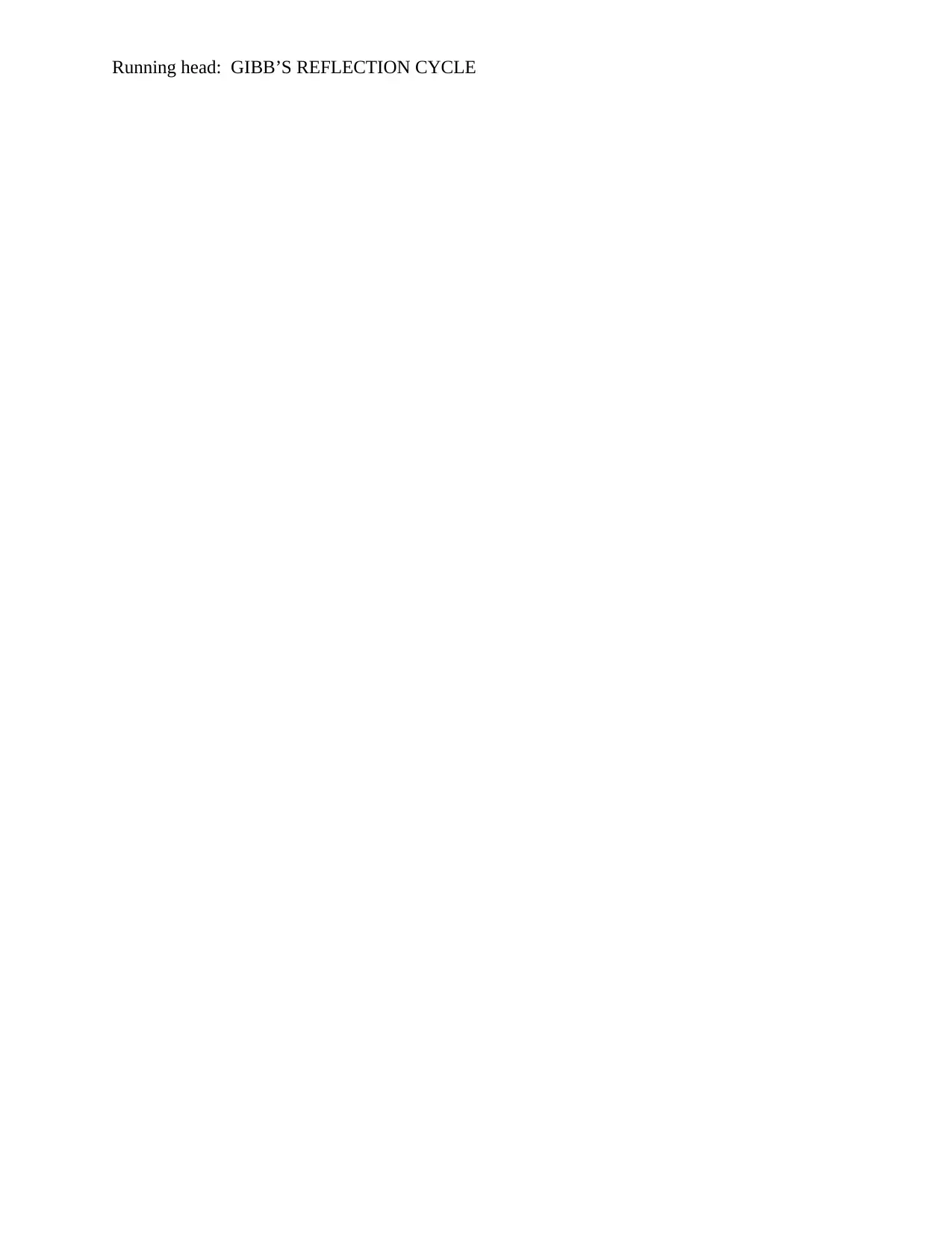
Running head: GIBB’S REFLECTION CYCLE
Paraphrase This Document
Need a fresh take? Get an instant paraphrase of this document with our AI Paraphraser
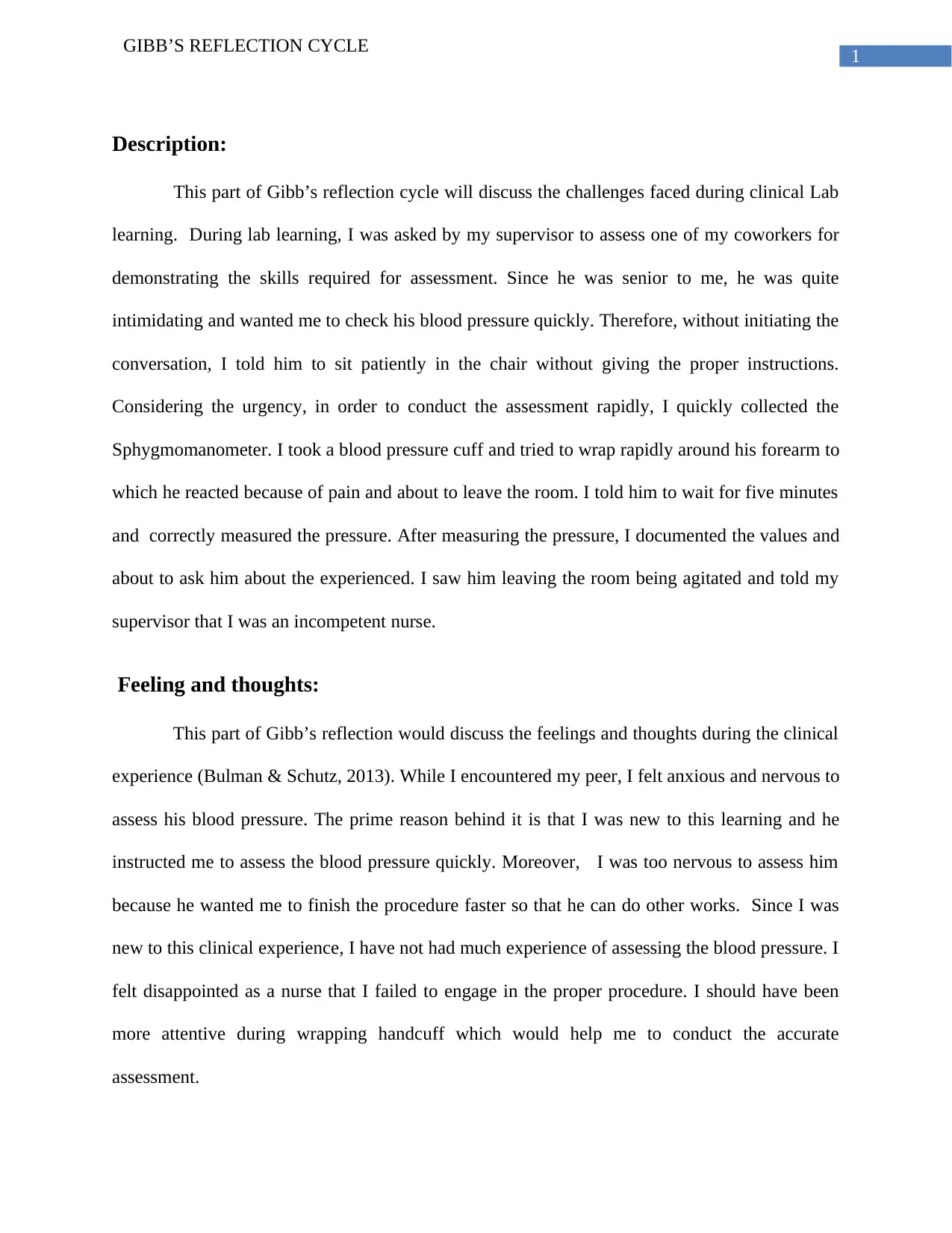
1
GIBB’S REFLECTION CYCLE
Description:
This part of Gibb’s reflection cycle will discuss the challenges faced during clinical Lab
learning. During lab learning, I was asked by my supervisor to assess one of my coworkers for
demonstrating the skills required for assessment. Since he was senior to me, he was quite
intimidating and wanted me to check his blood pressure quickly. Therefore, without initiating the
conversation, I told him to sit patiently in the chair without giving the proper instructions.
Considering the urgency, in order to conduct the assessment rapidly, I quickly collected the
Sphygmomanometer. I took a blood pressure cuff and tried to wrap rapidly around his forearm to
which he reacted because of pain and about to leave the room. I told him to wait for five minutes
and correctly measured the pressure. After measuring the pressure, I documented the values and
about to ask him about the experienced. I saw him leaving the room being agitated and told my
supervisor that I was an incompetent nurse.
Feeling and thoughts:
This part of Gibb’s reflection would discuss the feelings and thoughts during the clinical
experience (Bulman & Schutz, 2013). While I encountered my peer, I felt anxious and nervous to
assess his blood pressure. The prime reason behind it is that I was new to this learning and he
instructed me to assess the blood pressure quickly. Moreover, I was too nervous to assess him
because he wanted me to finish the procedure faster so that he can do other works. Since I was
new to this clinical experience, I have not had much experience of assessing the blood pressure. I
felt disappointed as a nurse that I failed to engage in the proper procedure. I should have been
more attentive during wrapping handcuff which would help me to conduct the accurate
assessment.
GIBB’S REFLECTION CYCLE
Description:
This part of Gibb’s reflection cycle will discuss the challenges faced during clinical Lab
learning. During lab learning, I was asked by my supervisor to assess one of my coworkers for
demonstrating the skills required for assessment. Since he was senior to me, he was quite
intimidating and wanted me to check his blood pressure quickly. Therefore, without initiating the
conversation, I told him to sit patiently in the chair without giving the proper instructions.
Considering the urgency, in order to conduct the assessment rapidly, I quickly collected the
Sphygmomanometer. I took a blood pressure cuff and tried to wrap rapidly around his forearm to
which he reacted because of pain and about to leave the room. I told him to wait for five minutes
and correctly measured the pressure. After measuring the pressure, I documented the values and
about to ask him about the experienced. I saw him leaving the room being agitated and told my
supervisor that I was an incompetent nurse.
Feeling and thoughts:
This part of Gibb’s reflection would discuss the feelings and thoughts during the clinical
experience (Bulman & Schutz, 2013). While I encountered my peer, I felt anxious and nervous to
assess his blood pressure. The prime reason behind it is that I was new to this learning and he
instructed me to assess the blood pressure quickly. Moreover, I was too nervous to assess him
because he wanted me to finish the procedure faster so that he can do other works. Since I was
new to this clinical experience, I have not had much experience of assessing the blood pressure. I
felt disappointed as a nurse that I failed to engage in the proper procedure. I should have been
more attentive during wrapping handcuff which would help me to conduct the accurate
assessment.
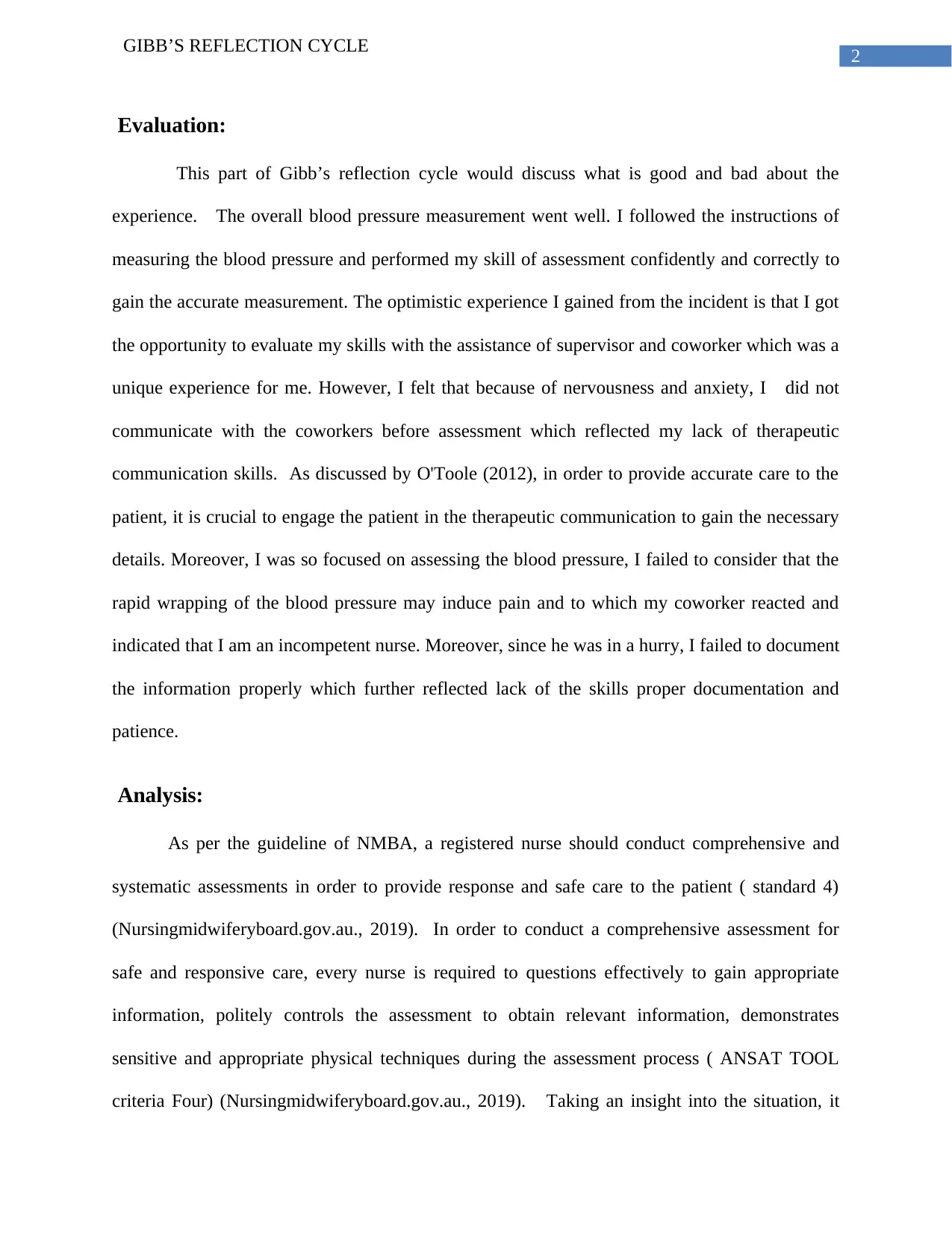
2
GIBB’S REFLECTION CYCLE
Evaluation:
This part of Gibb’s reflection cycle would discuss what is good and bad about the
experience. The overall blood pressure measurement went well. I followed the instructions of
measuring the blood pressure and performed my skill of assessment confidently and correctly to
gain the accurate measurement. The optimistic experience I gained from the incident is that I got
the opportunity to evaluate my skills with the assistance of supervisor and coworker which was a
unique experience for me. However, I felt that because of nervousness and anxiety, I did not
communicate with the coworkers before assessment which reflected my lack of therapeutic
communication skills. As discussed by O'Toole (2012), in order to provide accurate care to the
patient, it is crucial to engage the patient in the therapeutic communication to gain the necessary
details. Moreover, I was so focused on assessing the blood pressure, I failed to consider that the
rapid wrapping of the blood pressure may induce pain and to which my coworker reacted and
indicated that I am an incompetent nurse. Moreover, since he was in a hurry, I failed to document
the information properly which further reflected lack of the skills proper documentation and
patience.
Analysis:
As per the guideline of NMBA, a registered nurse should conduct comprehensive and
systematic assessments in order to provide response and safe care to the patient ( standard 4)
(Nursingmidwiferyboard.gov.au., 2019). In order to conduct a comprehensive assessment for
safe and responsive care, every nurse is required to questions effectively to gain appropriate
information, politely controls the assessment to obtain relevant information, demonstrates
sensitive and appropriate physical techniques during the assessment process ( ANSAT TOOL
criteria Four) (Nursingmidwiferyboard.gov.au., 2019). Taking an insight into the situation, it
GIBB’S REFLECTION CYCLE
Evaluation:
This part of Gibb’s reflection cycle would discuss what is good and bad about the
experience. The overall blood pressure measurement went well. I followed the instructions of
measuring the blood pressure and performed my skill of assessment confidently and correctly to
gain the accurate measurement. The optimistic experience I gained from the incident is that I got
the opportunity to evaluate my skills with the assistance of supervisor and coworker which was a
unique experience for me. However, I felt that because of nervousness and anxiety, I did not
communicate with the coworkers before assessment which reflected my lack of therapeutic
communication skills. As discussed by O'Toole (2012), in order to provide accurate care to the
patient, it is crucial to engage the patient in the therapeutic communication to gain the necessary
details. Moreover, I was so focused on assessing the blood pressure, I failed to consider that the
rapid wrapping of the blood pressure may induce pain and to which my coworker reacted and
indicated that I am an incompetent nurse. Moreover, since he was in a hurry, I failed to document
the information properly which further reflected lack of the skills proper documentation and
patience.
Analysis:
As per the guideline of NMBA, a registered nurse should conduct comprehensive and
systematic assessments in order to provide response and safe care to the patient ( standard 4)
(Nursingmidwiferyboard.gov.au., 2019). In order to conduct a comprehensive assessment for
safe and responsive care, every nurse is required to questions effectively to gain appropriate
information, politely controls the assessment to obtain relevant information, demonstrates
sensitive and appropriate physical techniques during the assessment process ( ANSAT TOOL
criteria Four) (Nursingmidwiferyboard.gov.au., 2019). Taking an insight into the situation, it
⊘ This is a preview!⊘
Do you want full access?
Subscribe today to unlock all pages.

Trusted by 1+ million students worldwide
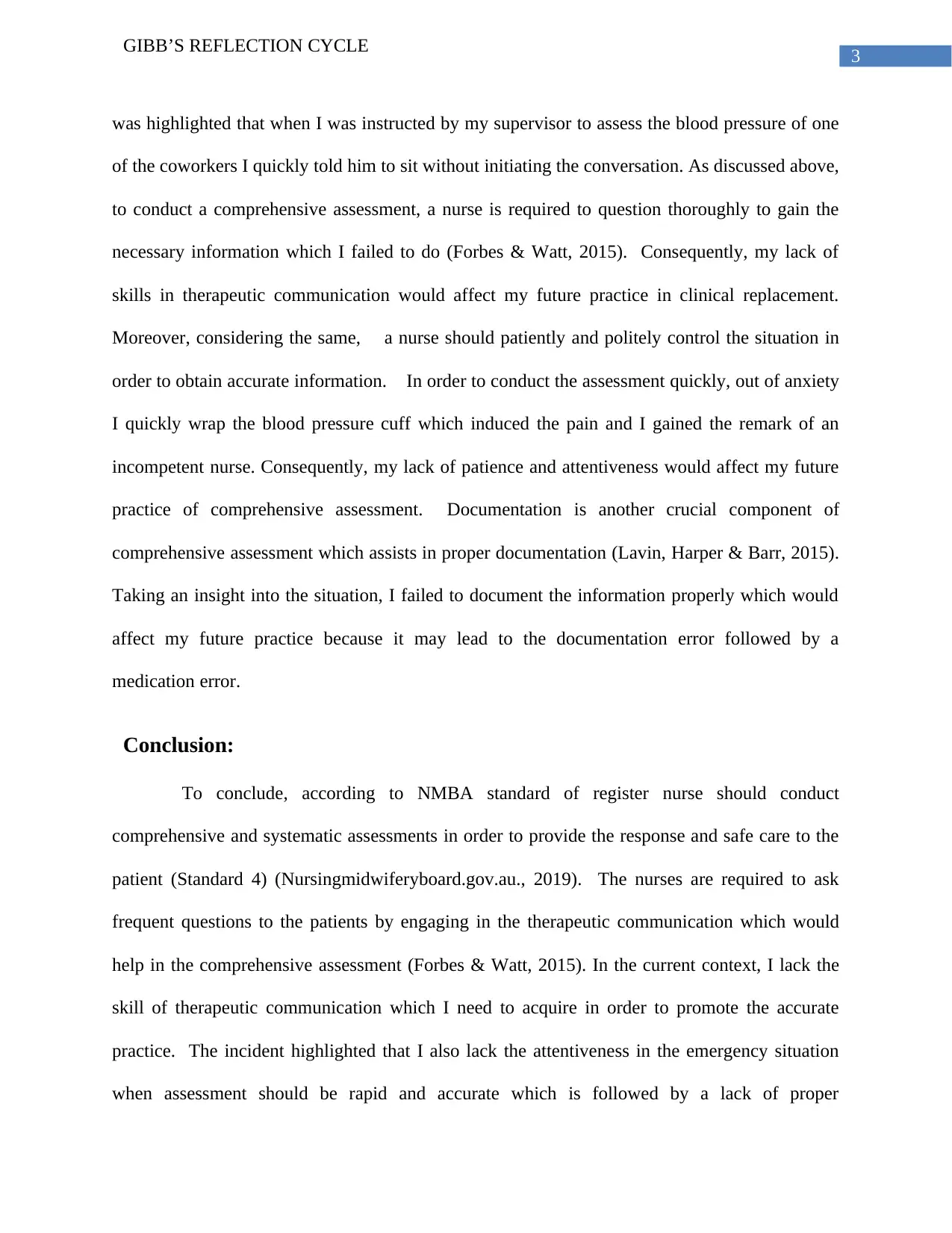
3
GIBB’S REFLECTION CYCLE
was highlighted that when I was instructed by my supervisor to assess the blood pressure of one
of the coworkers I quickly told him to sit without initiating the conversation. As discussed above,
to conduct a comprehensive assessment, a nurse is required to question thoroughly to gain the
necessary information which I failed to do (Forbes & Watt, 2015). Consequently, my lack of
skills in therapeutic communication would affect my future practice in clinical replacement.
Moreover, considering the same, a nurse should patiently and politely control the situation in
order to obtain accurate information. In order to conduct the assessment quickly, out of anxiety
I quickly wrap the blood pressure cuff which induced the pain and I gained the remark of an
incompetent nurse. Consequently, my lack of patience and attentiveness would affect my future
practice of comprehensive assessment. Documentation is another crucial component of
comprehensive assessment which assists in proper documentation (Lavin, Harper & Barr, 2015).
Taking an insight into the situation, I failed to document the information properly which would
affect my future practice because it may lead to the documentation error followed by a
medication error.
Conclusion:
To conclude, according to NMBA standard of register nurse should conduct
comprehensive and systematic assessments in order to provide the response and safe care to the
patient (Standard 4) (Nursingmidwiferyboard.gov.au., 2019). The nurses are required to ask
frequent questions to the patients by engaging in the therapeutic communication which would
help in the comprehensive assessment (Forbes & Watt, 2015). In the current context, I lack the
skill of therapeutic communication which I need to acquire in order to promote the accurate
practice. The incident highlighted that I also lack the attentiveness in the emergency situation
when assessment should be rapid and accurate which is followed by a lack of proper
GIBB’S REFLECTION CYCLE
was highlighted that when I was instructed by my supervisor to assess the blood pressure of one
of the coworkers I quickly told him to sit without initiating the conversation. As discussed above,
to conduct a comprehensive assessment, a nurse is required to question thoroughly to gain the
necessary information which I failed to do (Forbes & Watt, 2015). Consequently, my lack of
skills in therapeutic communication would affect my future practice in clinical replacement.
Moreover, considering the same, a nurse should patiently and politely control the situation in
order to obtain accurate information. In order to conduct the assessment quickly, out of anxiety
I quickly wrap the blood pressure cuff which induced the pain and I gained the remark of an
incompetent nurse. Consequently, my lack of patience and attentiveness would affect my future
practice of comprehensive assessment. Documentation is another crucial component of
comprehensive assessment which assists in proper documentation (Lavin, Harper & Barr, 2015).
Taking an insight into the situation, I failed to document the information properly which would
affect my future practice because it may lead to the documentation error followed by a
medication error.
Conclusion:
To conclude, according to NMBA standard of register nurse should conduct
comprehensive and systematic assessments in order to provide the response and safe care to the
patient (Standard 4) (Nursingmidwiferyboard.gov.au., 2019). The nurses are required to ask
frequent questions to the patients by engaging in the therapeutic communication which would
help in the comprehensive assessment (Forbes & Watt, 2015). In the current context, I lack the
skill of therapeutic communication which I need to acquire in order to promote the accurate
practice. The incident highlighted that I also lack the attentiveness in the emergency situation
when assessment should be rapid and accurate which is followed by a lack of proper
Paraphrase This Document
Need a fresh take? Get an instant paraphrase of this document with our AI Paraphraser
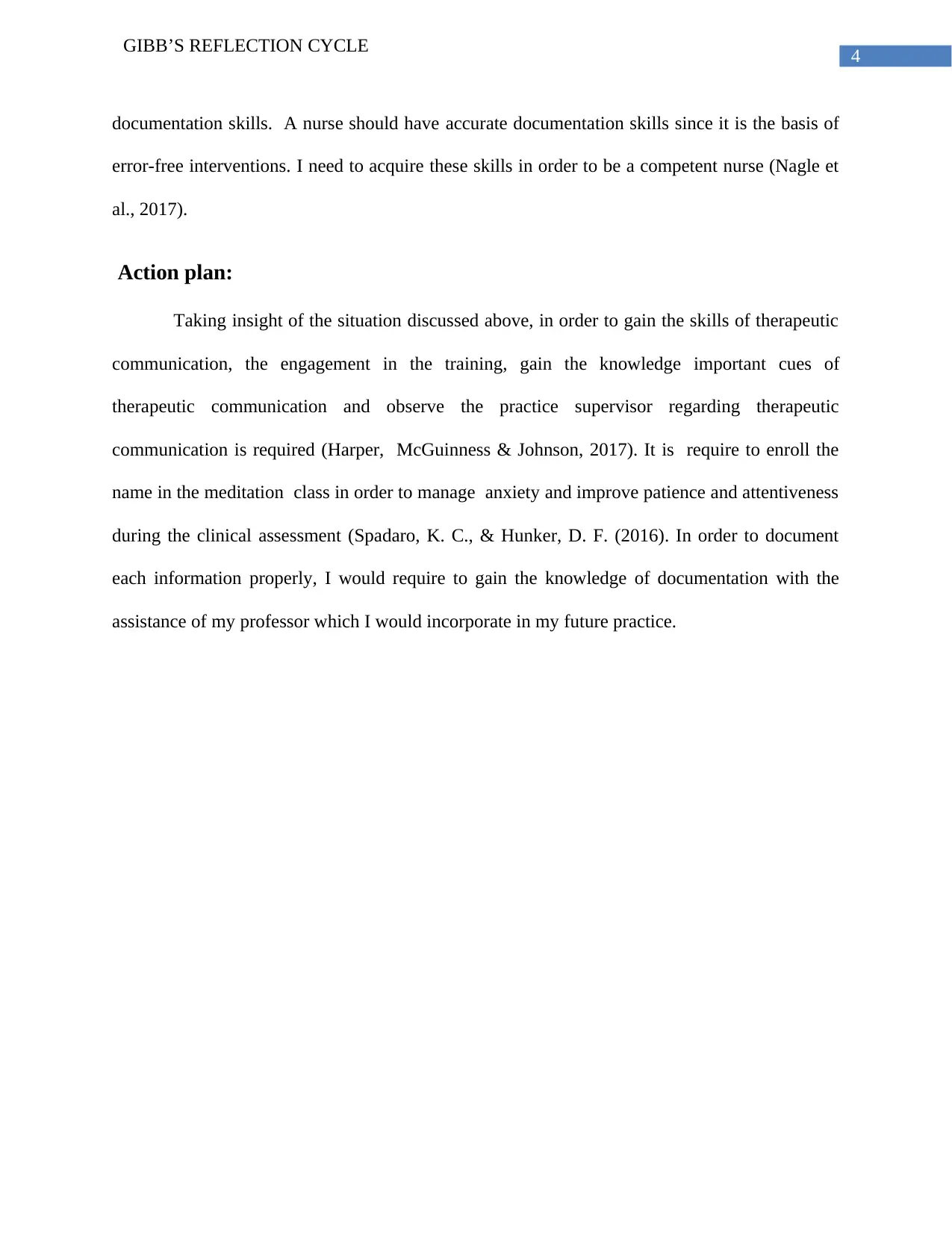
4
GIBB’S REFLECTION CYCLE
documentation skills. A nurse should have accurate documentation skills since it is the basis of
error-free interventions. I need to acquire these skills in order to be a competent nurse (Nagle et
al., 2017).
Action plan:
Taking insight of the situation discussed above, in order to gain the skills of therapeutic
communication, the engagement in the training, gain the knowledge important cues of
therapeutic communication and observe the practice supervisor regarding therapeutic
communication is required (Harper, McGuinness & Johnson, 2017). It is require to enroll the
name in the meditation class in order to manage anxiety and improve patience and attentiveness
during the clinical assessment (Spadaro, K. C., & Hunker, D. F. (2016). In order to document
each information properly, I would require to gain the knowledge of documentation with the
assistance of my professor which I would incorporate in my future practice.
GIBB’S REFLECTION CYCLE
documentation skills. A nurse should have accurate documentation skills since it is the basis of
error-free interventions. I need to acquire these skills in order to be a competent nurse (Nagle et
al., 2017).
Action plan:
Taking insight of the situation discussed above, in order to gain the skills of therapeutic
communication, the engagement in the training, gain the knowledge important cues of
therapeutic communication and observe the practice supervisor regarding therapeutic
communication is required (Harper, McGuinness & Johnson, 2017). It is require to enroll the
name in the meditation class in order to manage anxiety and improve patience and attentiveness
during the clinical assessment (Spadaro, K. C., & Hunker, D. F. (2016). In order to document
each information properly, I would require to gain the knowledge of documentation with the
assistance of my professor which I would incorporate in my future practice.
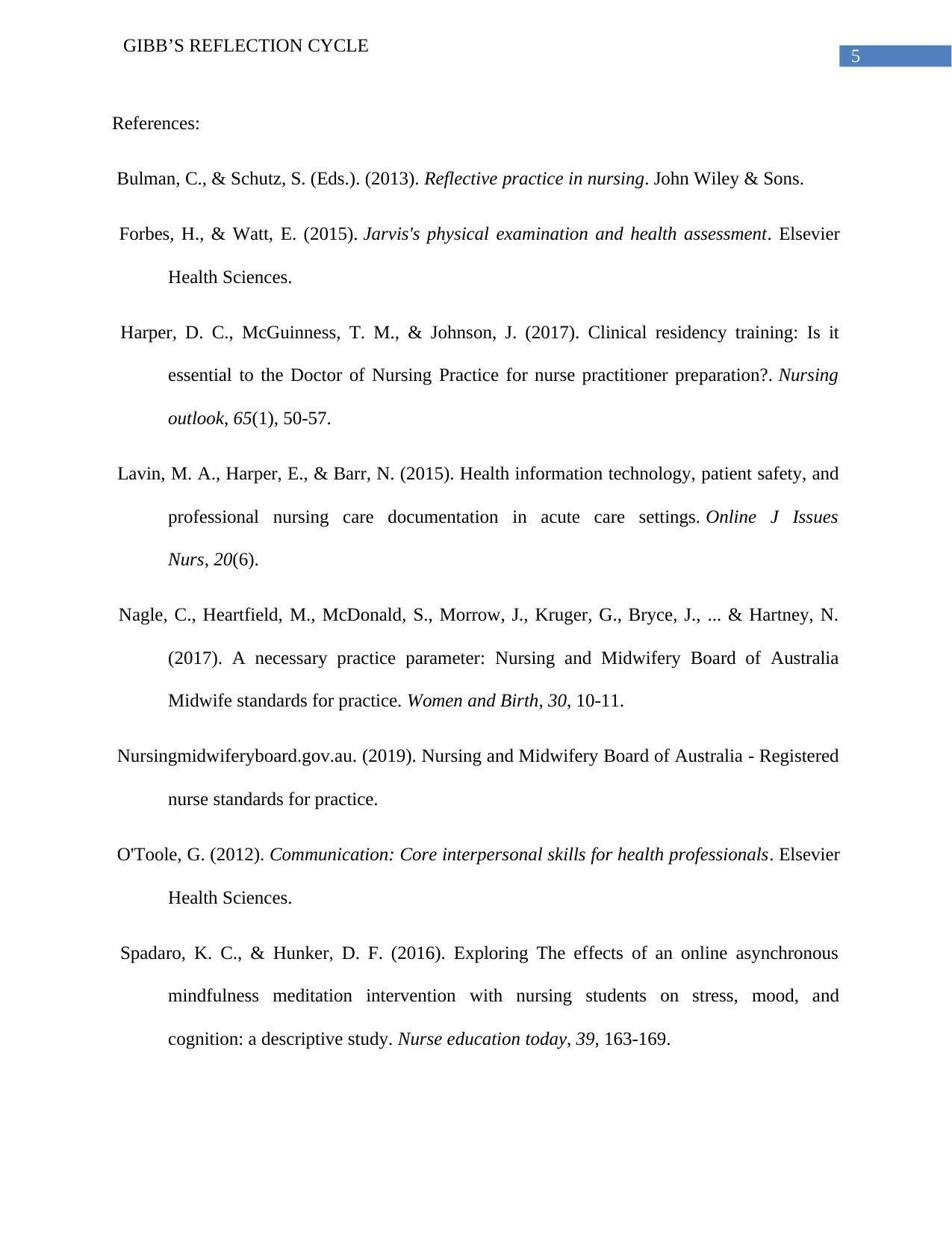
5
GIBB’S REFLECTION CYCLE
References:
Bulman, C., & Schutz, S. (Eds.). (2013). Reflective practice in nursing. John Wiley & Sons.
Forbes, H., & Watt, E. (2015). Jarvis's physical examination and health assessment. Elsevier
Health Sciences.
Harper, D. C., McGuinness, T. M., & Johnson, J. (2017). Clinical residency training: Is it
essential to the Doctor of Nursing Practice for nurse practitioner preparation?. Nursing
outlook, 65(1), 50-57.
Lavin, M. A., Harper, E., & Barr, N. (2015). Health information technology, patient safety, and
professional nursing care documentation in acute care settings. Online J Issues
Nurs, 20(6).
Nagle, C., Heartfield, M., McDonald, S., Morrow, J., Kruger, G., Bryce, J., ... & Hartney, N.
(2017). A necessary practice parameter: Nursing and Midwifery Board of Australia
Midwife standards for practice. Women and Birth, 30, 10-11.
Nursingmidwiferyboard.gov.au. (2019). Nursing and Midwifery Board of Australia - Registered
nurse standards for practice.
O'Toole, G. (2012). Communication: Core interpersonal skills for health professionals. Elsevier
Health Sciences.
Spadaro, K. C., & Hunker, D. F. (2016). Exploring The effects of an online asynchronous
mindfulness meditation intervention with nursing students on stress, mood, and
cognition: a descriptive study. Nurse education today, 39, 163-169.
GIBB’S REFLECTION CYCLE
References:
Bulman, C., & Schutz, S. (Eds.). (2013). Reflective practice in nursing. John Wiley & Sons.
Forbes, H., & Watt, E. (2015). Jarvis's physical examination and health assessment. Elsevier
Health Sciences.
Harper, D. C., McGuinness, T. M., & Johnson, J. (2017). Clinical residency training: Is it
essential to the Doctor of Nursing Practice for nurse practitioner preparation?. Nursing
outlook, 65(1), 50-57.
Lavin, M. A., Harper, E., & Barr, N. (2015). Health information technology, patient safety, and
professional nursing care documentation in acute care settings. Online J Issues
Nurs, 20(6).
Nagle, C., Heartfield, M., McDonald, S., Morrow, J., Kruger, G., Bryce, J., ... & Hartney, N.
(2017). A necessary practice parameter: Nursing and Midwifery Board of Australia
Midwife standards for practice. Women and Birth, 30, 10-11.
Nursingmidwiferyboard.gov.au. (2019). Nursing and Midwifery Board of Australia - Registered
nurse standards for practice.
O'Toole, G. (2012). Communication: Core interpersonal skills for health professionals. Elsevier
Health Sciences.
Spadaro, K. C., & Hunker, D. F. (2016). Exploring The effects of an online asynchronous
mindfulness meditation intervention with nursing students on stress, mood, and
cognition: a descriptive study. Nurse education today, 39, 163-169.
⊘ This is a preview!⊘
Do you want full access?
Subscribe today to unlock all pages.

Trusted by 1+ million students worldwide

6
GIBB’S REFLECTION CYCLE
GIBB’S REFLECTION CYCLE
1 out of 7
Related Documents
Your All-in-One AI-Powered Toolkit for Academic Success.
+13062052269
info@desklib.com
Available 24*7 on WhatsApp / Email
![[object Object]](/_next/static/media/star-bottom.7253800d.svg)
Unlock your academic potential
Copyright © 2020–2025 A2Z Services. All Rights Reserved. Developed and managed by ZUCOL.




